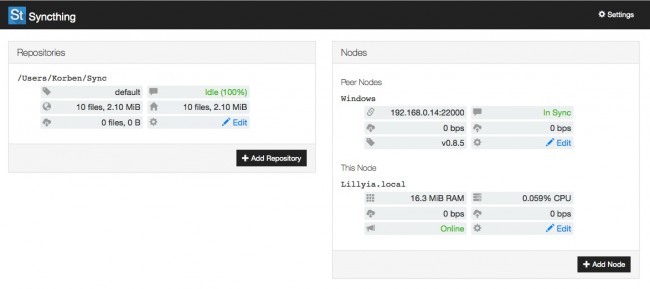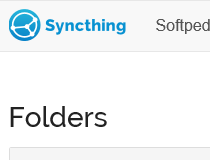
Synchronize as many folders as you need with different people. Just give your ID to your friends, share a folder and watch: UPnP will do if you don’t want to port forward or you don’t know how. Syncthing doesn’t need IP addresses or advanced configuration: it just works, over LAN and over the Internet. Run it on your desktop computers and synchronize them with your server for backup. This is the summary version of the goal list - for more commentary, see the full Goals document. The goals are listed in order of importance, the most important one being the first.

It synchronizes files between two or more computers.
#Syncthing logo mac os#
Works on Mac OS X, Windows, Linux, FreeBSD, Solaris and OpenBSD. Syncthing is a continuous file synchronization program. Configure and monitor Syncthing via a responsive and powerful interface accessible via your browser. Syncthing is still in development, although a large number of features have already been implemented: Only nodes you have explicitly allowed can connect to your cluster.
#Syncthing logo install#
To install Syncthing within the WikiSuite environment, follow the next steps. Every node is identified by a strong cryptographic certificate. Syncthing is a file synchronization tool. The encryption used includes perfect forward secrecy to prevent any eavesdropper from ever gaining access to your data. There is no central server that might be compromised, legally or illegally. None of your data is ever stored anywhere else other than on your computers. Your data is your data alone and you deserve to choose where it is stored, if it is shared with some third party and how it’s transmitted over the Internet. It supports a wide range of chip architecture, including i386, 圆4 and ARM.Syncthing replaces proprietary sync and cloud services with something open, trustworthy and decentralized. Syncthing runs on Windows, Mac OS, Linux, Android and various NAS drives. Those wishing to run Syncthing on older 32-bit machines should click here for the relevant download links.

You can download - and read our review of - Syncthing 1.0.0 64-bit here. Data is transferred directly between clients using P2P technology, which - thanks to built-in encryption - ensures it’s never in the hands of a third party. The key difference between Syncthing and other cloud providers is that there is no central repository. The decision to bump to Syncthing to a stable release comes from lead developer Borg’s realization that the application is now over five years old, and should no longer be considered unsuitable for production use given each previously 'stable' beta release gets over a million downloads from GitHub alone.Īlthough the application moves away from being in a perpetual state of beta, Borg is keen to stress that "the journey of development continues".įor those unaware of what Syncthing is, it’s a personal sync tool that emulates the function of cloud backup services in simplifying a user’s ability to keep folders in sync across multiple computers, mobiles and other devices, whether they’re on the same network or spread across the wider internet. Four enhancements have also been implemented, including an option to limit the maximum number of simultaneous scans, new hardening options for system units, plus the display of any configured rate limits in the GUI and a list of locally changed files for any folders set to only receive changes from other peers.
#Syncthing logo update#
That update offered three minor bugfixes, including one where the event system could cause a deadlock.

Indeed, version 1.0.0 is identical to the 0.14.55-rc.2 release candidate, which immediately precedes it. Although Syncthing has reached a milestone release, it’s not down to any major new features.


 0 kommentar(er)
0 kommentar(er)
